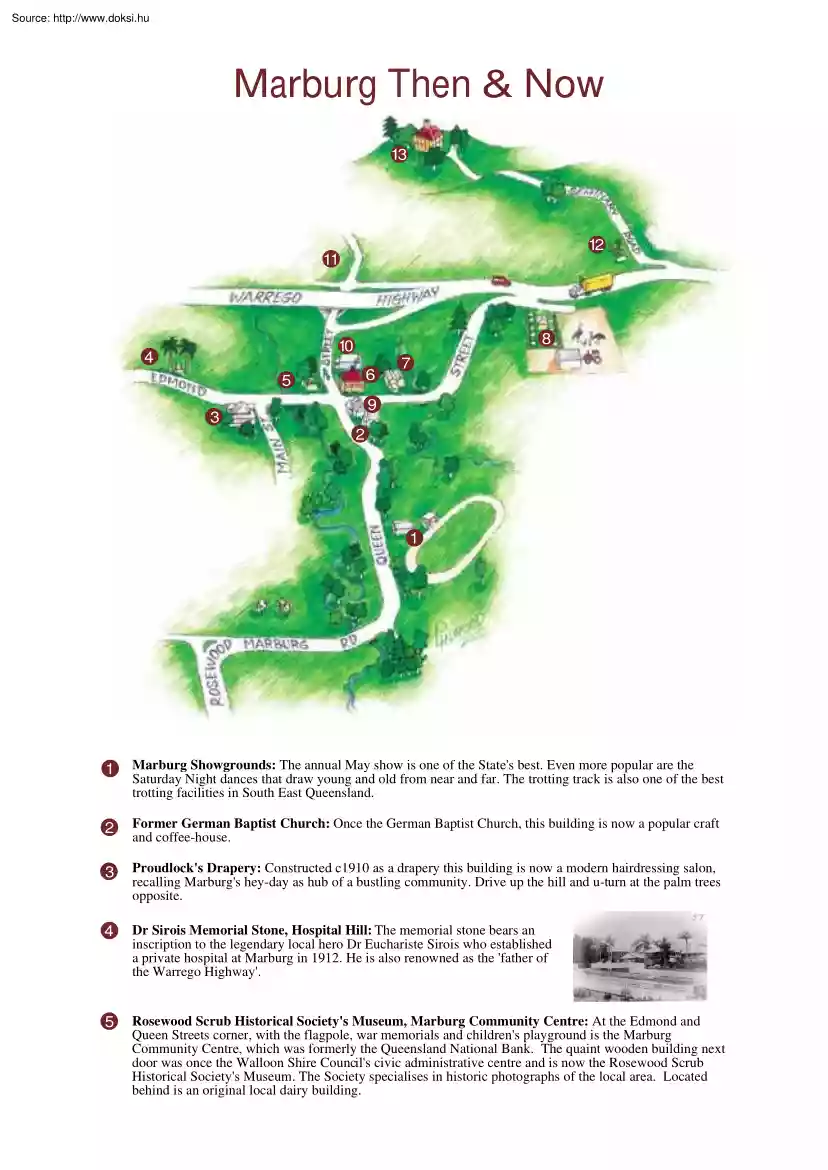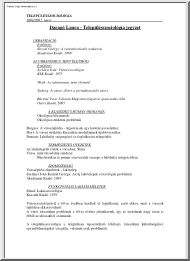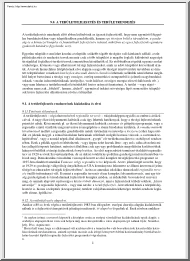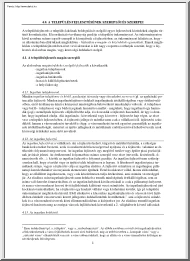Datasheet
Year, pagecount:2014, 2 page(s)
Language:English
Downloads:4
Uploaded:June 21, 2014
Size:150 KB
Institution:
-
Comments:
Attachment:-
Download in PDF:Please log in!
Comments
No comments yet. You can be the first!Content extract
Marburg Then & Now 13 11 12 11 8 10 4 4 6 5 7 9 33 2 1 1 Marburg Showgrounds: The annual May show is one of the States best. Even more popular are the Saturday Night dances that draw young and old from near and far. The trotting track is also one of the best trotting facilities in South East Queensland. 2 Former German Baptist Church: Once the German Baptist Church, this building is now a popular craft and coffee-house. 3 Proudlocks Drapery: Constructed c1910 as a drapery this building is now a modern hairdressing salon, recalling Marburgs hey-day as hub of a bustling community. Drive up the hill and u-turn at the palm trees opposite. 4 Dr Sirois Memorial Stone, Hospital Hill: The memorial stone bears an inscription to the legendary local hero Dr Euchariste Sirois who established a private hospital at Marburg in 1912. He is also renowned as the father of the Warrego Highway. 5 Rosewood Scrub Historical Societys Museum, Marburg Community Centre: At the Edmond
and Queen Streets corner, with the flagpole, war memorials and childrens playground is the Marburg Community Centre, which was formerly the Queensland National Bank. The quaint wooden building next door was once the Walloon Shire Councils civic administrative centre and is now the Rosewood Scrub Historical Societys Museum. The Society specialises in historic photographs of the local area Located behind is an original local dairy building. 6 Marburg Hotel: Built in 1879, the Marburg Hotel was the centrepiece of the film The Settlement. Originally a one storey building the second storey was added in 1885. Historic photo c1880’s. 7 Picture Theatre: Located 50 metres east of the Marburg Hotel in Edmond Street is part of the galvanised iron motor works complex. In pre-television days the eastern side of this building was used as a picture theatre. 8 Trinity Lutheran Cemetery: A burial ground with headstones marking the graves of many German pioneers and residents of the Marburg
area. Please note the Marburg Emu Farm on the eastern side of the cemetery. 9 Former Bielefelds Store: The building on the corner opposite the Marburg Hotel was once the former Bielefelds Store and is now home to an Australia Post Office and a centre for antiques and collectibles. The former ‘Frederich’s store stood on this site’. 10 Marburg Police Station: Incorporates the former courthouse, a small single cell lock-up and the police residence. 11 Marburg School: The school was opened 1879 and was originally named Frederich School. The school was moved to its current location in 1922 as the Marburg Rural School. Marburg has the first school forest plot in Queensland, established in 1928 when 275 trees (Hoop Pines) were planted. 12 Marburg Anglican Cemetery: The resting place of many pioneers of the Rosewood Scrub. A cluster of tall trees on the hill to the north identifies the palatial mansion of Woodlands. Opposite the cemetery is a winery which is open for tours &
tastings. 13 Woodlands: Built by timber and sugar entrepreneur, Thomas Lorimer Smith. It was purchased by the Catholic Order of the Divine Word after World War II. Many artifacts, including the Order’s Grotto, still survive. Woodlands has been used by the Ipswich Grammar School as a corporate retreat, conference centre and outdoor education centre. Historical Facts + The town is named after Marburg in the North German State of Hesse-Nassau. Many of the early settlers in the Marburg area had emigrated from Germany. + + Timber getting in the Rosewood Scrub was an early industry in the district. + The streets of Marburg were lit with electricity in 1885 for the opening of the School of Arts. A special line was erected from the electrical plant at Woodlands mill to Marburg for the occasion. + + + + Marburg once had its own butter factory initiated by storekeeper Mr Friedrich. A sugar plantation and sugar mill were started nearby at Woodlands in the early 1880s. South Sea
Islanders worked there, and many local farmers also grew cane to supply the mill. French-Canadian doctor Euchariste Sirois opened a hospital in Marburg in 1912. During World War I, the name was changed to Townshend but it reverted to its original name in 1920. From the 1920s to the 1970s, the main highway passed through Marburg. Because it was half way from Brisbane to Toowoomba, many travellers stopped there and Days Café became known as "The Half-Way Café". Day’s Café Marburg c1930’s: The former café building remains in Edmond Street (across from the Marburg Hotel) and is now used as part of the Antique Centre
and Queen Streets corner, with the flagpole, war memorials and childrens playground is the Marburg Community Centre, which was formerly the Queensland National Bank. The quaint wooden building next door was once the Walloon Shire Councils civic administrative centre and is now the Rosewood Scrub Historical Societys Museum. The Society specialises in historic photographs of the local area Located behind is an original local dairy building. 6 Marburg Hotel: Built in 1879, the Marburg Hotel was the centrepiece of the film The Settlement. Originally a one storey building the second storey was added in 1885. Historic photo c1880’s. 7 Picture Theatre: Located 50 metres east of the Marburg Hotel in Edmond Street is part of the galvanised iron motor works complex. In pre-television days the eastern side of this building was used as a picture theatre. 8 Trinity Lutheran Cemetery: A burial ground with headstones marking the graves of many German pioneers and residents of the Marburg
area. Please note the Marburg Emu Farm on the eastern side of the cemetery. 9 Former Bielefelds Store: The building on the corner opposite the Marburg Hotel was once the former Bielefelds Store and is now home to an Australia Post Office and a centre for antiques and collectibles. The former ‘Frederich’s store stood on this site’. 10 Marburg Police Station: Incorporates the former courthouse, a small single cell lock-up and the police residence. 11 Marburg School: The school was opened 1879 and was originally named Frederich School. The school was moved to its current location in 1922 as the Marburg Rural School. Marburg has the first school forest plot in Queensland, established in 1928 when 275 trees (Hoop Pines) were planted. 12 Marburg Anglican Cemetery: The resting place of many pioneers of the Rosewood Scrub. A cluster of tall trees on the hill to the north identifies the palatial mansion of Woodlands. Opposite the cemetery is a winery which is open for tours &
tastings. 13 Woodlands: Built by timber and sugar entrepreneur, Thomas Lorimer Smith. It was purchased by the Catholic Order of the Divine Word after World War II. Many artifacts, including the Order’s Grotto, still survive. Woodlands has been used by the Ipswich Grammar School as a corporate retreat, conference centre and outdoor education centre. Historical Facts + The town is named after Marburg in the North German State of Hesse-Nassau. Many of the early settlers in the Marburg area had emigrated from Germany. + + Timber getting in the Rosewood Scrub was an early industry in the district. + The streets of Marburg were lit with electricity in 1885 for the opening of the School of Arts. A special line was erected from the electrical plant at Woodlands mill to Marburg for the occasion. + + + + Marburg once had its own butter factory initiated by storekeeper Mr Friedrich. A sugar plantation and sugar mill were started nearby at Woodlands in the early 1880s. South Sea
Islanders worked there, and many local farmers also grew cane to supply the mill. French-Canadian doctor Euchariste Sirois opened a hospital in Marburg in 1912. During World War I, the name was changed to Townshend but it reverted to its original name in 1920. From the 1920s to the 1970s, the main highway passed through Marburg. Because it was half way from Brisbane to Toowoomba, many travellers stopped there and Days Café became known as "The Half-Way Café". Day’s Café Marburg c1930’s: The former café building remains in Edmond Street (across from the Marburg Hotel) and is now used as part of the Antique Centre





